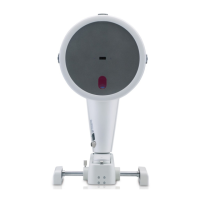103
14 Corneal Optical Densitometry display
14 The Corneal Optical Densitometry display,
by Sorcha S. Ní Dhubhghaill, MB, PhD,
Jos J. Rozema, MSc, PhD
Gaining a sense of the structural situation in corneal pathologies can be difficult based on raw
Scheimpflug images alone. For this reason the method of tomographic reconstruction was introduced,
which provides cross-sections along the three cardinal axes. However, as ocular structures often do
not lie within a flat plane, structures at similar depths in the cornea often can appear at different
depths in the tomography, hindering their assessment.
This is where the corneal densitometry screen comes in useful in that it presents scatter data over
a curved plane that is interpolated between the anterior and posterior corneal surfaces. This means
that all structures visible in the map are located at the same relative distance from the corneal
surfaces, making it a useful tool for assessing the depth and position of scattering phenomena that
may occur within the cornea.
What is the clinical utility of corneal densitometry?
If performed in uniform conditions, densitometry assessment can be used for making repeatable,
reproducible measuremements of corneal haze. Densitometry measurements have been used for
following up corneal haze in patients post LASIK or post PRK, or with infectious keratitis, corneal
mucopolusaccharidosis and keratoconus. The scan protocol is simple and does not lengthen the
Pentacam® scan time. We will here describe some of our experiences using this technique.
Applications and Limitations
Any condition that induces a corneal haze or opacity can be objectively assessed using the
densitometry approach, provided that the cornea is not opaque. If the cornea is very hazy or opaque,
the backscatter will be too high and the measurements unreliable. Corneal densitometry also
increases with age in the periphery but remains stable centrally [30].
Note
Densitometry values near the limbus (10 mm – 12 mm from central fixation) should also be
interpreted with caution, as scleral backscatter can artificially elevate the values in this area.

